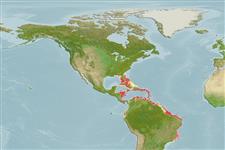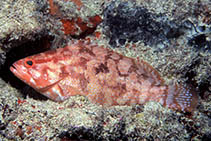Add your observation in Fish Watcher
| Native range | All suitable habitat | Point map | Year 2050 |

|
| This map was computer-generated and has not yet been reviewed. |
| Alphestes afer AquaMaps Data sources: GBIF OBIS |
Upload your photos and videos
Pictures | Sounds | Google imageAlphestes afer
Picture by Rocha, L.A.
Pictures | Sounds | Google imageAlphestes afer
Picture by Rocha, L.A.
Classification / Names Nomi Comuni | Sinonimi | Catalog of Fishes(Genere, Specie) | ITIS | CoL | WoRMS | Cloffa
> Perciformes/Serranoidei (Groupers) > Epinephelidae (Groupers)
Etymology: Alphestes: Greek, alphestes, -oy = a kind of fish (Ref. 45335).
More on author: Bloch.
Etymology: Alphestes: Greek, alphestes, -oy = a kind of fish (Ref. 45335).
More on author: Bloch.
Environment: milieu / climate zone / depth range / distribution range Ecologia
marino associati a barriera corallina; non migratori; distribuzione batimetrica 2 - 30 m (Ref. 9710). Tropical; 32°N - 27°S, 86°W - 32°W (Ref. 5222)
Distribuzione Stati | Aree FAO | Ecosystems | Presenze | Point map | Introduzioni | Faunafri
Western Atlantic: Bermuda, south Florida (USA), Gulf of Mexico, the Bahamas, Cuba, West Indies, Panama, Venezuela, and southward to the state of São Paulo, Brazil. Alphestes afer has recently been re-discovered at São Tomé in the Gulf of Guinea of the Eastern Atlantic.
Length at first maturity / Size / Peso / Age
Maturity: Lm 18.0, range 18 - 18.4 cm
Max length : 33.0 cm TL maschio/sesso non determinato; (Ref. 5222)
Max length : 33.0 cm TL maschio/sesso non determinato; (Ref. 5222)
Short description Chiavi di identificazione | Morfologia | Morfometria
Spine dorsali (totale) : 11; Raggi dorsali molli (totale) : 17 - 20; Spine anali: 3; Raggi anali molli: 9 - 10. Diagnosis: Body depth is slightly less than head length, depth contained 2.4-3.1 (2.9) in standard length; caudal peduncle depth 7.0-9.0 (8.5) times in SL; eye diameter greater than or equal to snout length and 8.1-15.0 (13) times in SL; snout length 10.1-16.0 (16.0) times in SL; preopercle rounded, posterior edge serrate, with a large antrorse spine at the angle directed downward and forward and usually covered with skin. Gill rakers 5-8 (7) on upper limb, 14-17 (16) on lower limb, 19-25 (23) total, including rudiments. Dorsal fin with XI spines and 17 to 20 (18) soft rays, anal fin with III spines and 9, rarely 10 (10) soft rays; pectoral fins with 16 - 18 (17) rays; caudal fin rounded, with 15 branched rays. Scales are smooth. Lateral-line scales 49-66; lateral scale series 68 – 88 (76). Color in life; head, body, and median fins olivaceous or light brown, irregularly blotched and barred with dark brown. Some individuals are densely spotted with orange; head, body, and all fins often with scattered white spots; body sometimes covered with scattered small black dots; pectoral fins may be orange or yellow with faint dark reticulations (Ref. 57865); Color in market: almost similar to color in life but general body color may fade to a pale drab cream, also spots and reticulations may fade (Ref. 89707).
A solitary species (Ref. 26340) occurring in seagrass habitats. Sedentary during the day, hiding in crevices or lying among seaweed, sometimes partly covering itself with sand while lying on its side. Nocturnal feeders of benthic crustaceans. Estimated eggs per fish is from 157512 to 223706 (Ref. 29). Small, colorful group; a sequential hermaphrodite (Ref. 26938). Has been traded as an aquarium fish at Ceará, Brazil (Ref. 49392).
Life cycle and mating behavior Maturità | Riproduzione | Deposizione | Uova | Fecundity | Larve
Protogyny is unconfirmed for this species (Ref. 103751).
Main reference
Upload your references | Bibliografia | Coordinatore | Collaboratori
Heemstra, P.C. and J.E. Randall, 1993. FAO Species Catalogue. Vol. 16. Groupers of the world (family Serranidae, subfamily Epinephelinae). An annotated and illustrated catalogue of the grouper, rockcod, hind, coral grouper and lyretail species known to date. Rome: FAO. FAO Fish. Synop. 125(16):382 p. (Ref. 5222)
IUCN Red List Status (Ref. 130435: Version 2024-2)
Least Concern (LC) ; Date assessed: 19 December 2016
CITES
Not Evaluated
Threat to humans
Reports of ciguatera poisoning (Ref. 30303)
Human uses
Pesca: scarso interesse commerciale; Acquario: Commerciale
FAO - Publication: search | FishSource | Sea Around Us
Informazioni ulteriori
Population dynamics
Growth parameters
Max. ages / sizes
Length-weight rel.
Length-length rel.
Length-frequencies
Mass conversion
Reclutamento
Abbondanza
Growth parameters
Max. ages / sizes
Length-weight rel.
Length-length rel.
Length-frequencies
Mass conversion
Reclutamento
Abbondanza
Life cycle
Riproduzione
Maturità
Maturity/Gills rel.
Fecundity
Deposizione
Spawning aggregations
Uova
Egg development
Larve
Dinamica popolazioni larvali
Riproduzione
Maturità
Maturity/Gills rel.
Fecundity
Deposizione
Spawning aggregations
Uova
Egg development
Larve
Dinamica popolazioni larvali
Anatomy
Area branchiale
Brain
Otolith
Area branchiale
Brain
Otolith
Physiology
Body composition
Nutrients
Oxygen consumption
Swimming type
Swimming speed
Visual pigments
Fish sound
Diseases & Parasites
Toxicity (LC50s)
Body composition
Nutrients
Oxygen consumption
Swimming type
Swimming speed
Visual pigments
Fish sound
Diseases & Parasites
Toxicity (LC50s)
Genetics
Genetica
Heterozygosity
Ereditarietà
Genetica
Heterozygosity
Ereditarietà
Human related
Aquaculture systems
Profili di acquacoltura
Varietà
Ciguatera cases
Stamps, coins, misc.
Aquaculture systems
Profili di acquacoltura
Varietà
Ciguatera cases
Stamps, coins, misc.
Strumenti
E-book | Giuda pratica | Chiavi di identificazione | Generatore frequenze di lunghezza | Strumento Parametri Biologici | Mappa dei ritrovamenti | Classification Tree
| Catch-MSY |
Special reports
Download XML
Fonti Internet
AFORO (otoliths) | Aquatic Commons | BHL | Cloffa | BOLDSystems | Websites from users | Check FishWatcher | CISTI | Catalog of Fishes: Genere, Specie | DiscoverLife | ECOTOX | FAO - Publication: search | Faunafri | Fishipedia | Fishtrace | GenBank: genome, nucleotide | GloBI | Google Books | Google Scholar | Google | IGFA World Record | MitoFish | Database Nazionali | Otolith Atlas of Taiwan Fishes | Acquari pubblici | PubMed | Reef Life Survey | Socotra Atlas | Tree of Life | Wikipedia: Go, ricerca | World Records Freshwater Fishing | Zoological Record
Estimates based on models
Preferred temperature (Ref. 123201): 25.6 - 28.1, mean 27.5 °C (based on 668 cells).
Phylogenetic diversity index (Ref. 82804): PD50 = 0.6250 [Uniqueness, from 0.5 = low to 2.0 = high].
Bayesian length-weight: a=0.00447 (0.00259 - 0.00771), b=2.87 (2.73 - 3.01), in cm total length, based on LWR estimates for this species & (Sub)family-body (Ref. 93245).
Trophic level (Ref. 69278): 3.6 ±0.5 se; based on diet studies.
Resilienza (Ref. 120179): Alto, tempo minimo di raddoppiamento della popolazione meno di 15 mesi (Fec=150,000-220,000).
Fishing Vulnerability (Ref. 59153): Low vulnerability (23 of 100).
Nutrients (Ref. 124155): Calcium = 47.5 [29.1, 84.8] mg/100g; Iron = 0.557 [0.308, 0.928] mg/100g; Protein = 18.5 [16.7, 20.1] %; Omega3 = 0.143 [0.097, 0.216] g/100g; Selenium = 27.2 [17.3, 47.4] μg/100g; VitaminA = 106 [38, 322] μg/100g; Zinc = 1.22 [0.86, 1.71] mg/100g (wet weight);




